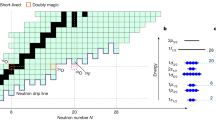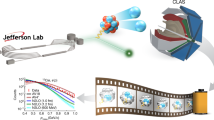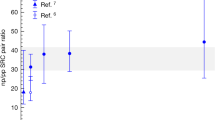Abstract
IN the nuclear reaction F19(p,α)O16, the oxygen nucleus can be produced in an excited state with an excitation energy of 5·9 MeV. The transition from this state to the ground state of O16 does not occur, as normally, by the emission of γ-radiation, but by the creation of electron-positron pairs1, this fact being interpreted as meaning that its excited state has zero total angular momentum (J), and since its ground state also has zero J, a single γ-radiation transition between the two states is impossible2. Alternative, competitive processes such as emission of two quanta or a two-step transition via a state of oxygen-16 intermediate between the ground state and that at 5·9 MeV. have not been observed ; the absence of the latter possibility is consistent with the absence of any evidence for an excited state of O16 below 5·9 MeV.
This is a preview of subscription content, access via your institution
Access options
Subscribe to this journal
Receive 51 print issues and online access
$199.00 per year
only $3.90 per issue
Buy this article
- Purchase on Springer Link
- Instant access to full article PDF
Prices may be subject to local taxes which are calculated during checkout
Similar content being viewed by others
References
Streib, J. F., Fowler, W. A., and Lauritsen, C. C., Phys. Rev., 59, 253 (1941).
Oppenheimer, J. R., Schwinger, J. S., Phys. Rev., 56, 1066 (1939).
Oppenheimer, J. R., Phys. Rev., 60, 964 (1941).
Author information
Authors and Affiliations
Rights and permissions
About this article
Cite this article
DEVONS, S., LINDSEY, G. Electron Pair Creation by a Spherically Symmetrical Field. Nature 164, 539–540 (1949). https://doi.org/10.1038/164539a0
Issue Date:
DOI: https://doi.org/10.1038/164539a0
This article is cited by
-
Angular correlations of electron-positron pairs in internal electric monopole conversion of aligned heavy nuclei
Zeitschrift für Physik A Hadrons and Nuclei (1996)
-
Life-Time for Pair Emission by Spherically Symmetrical Excited State of the O16 nucleus
Nature (1949)
Comments
By submitting a comment you agree to abide by our Terms and Community Guidelines. If you find something abusive or that does not comply with our terms or guidelines please flag it as inappropriate.



